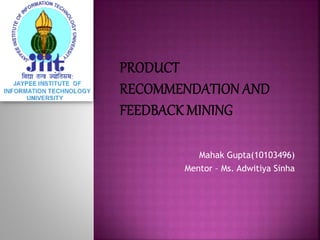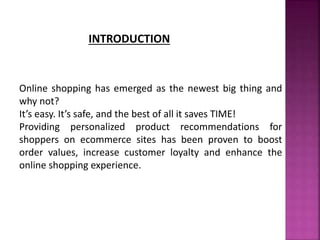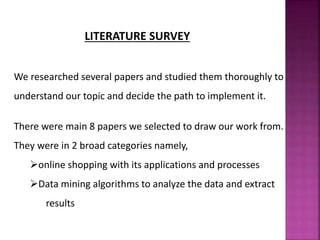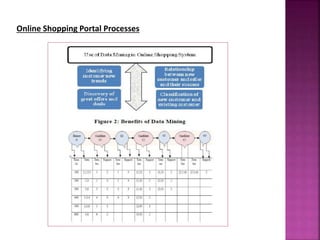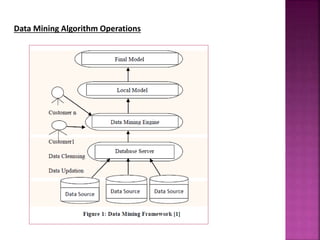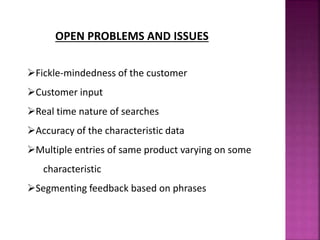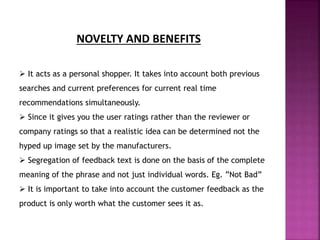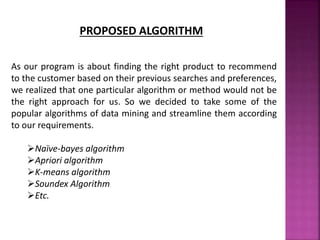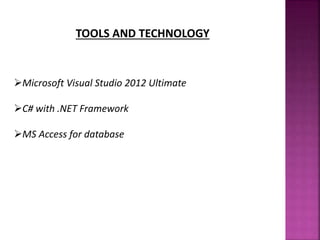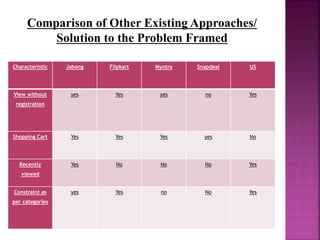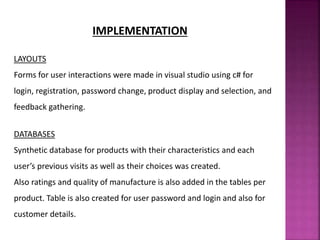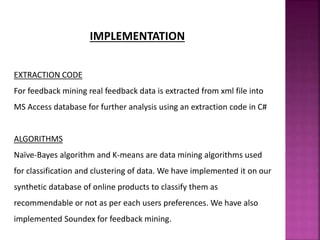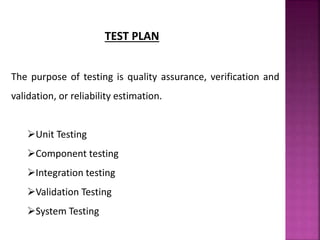Product recommendation and feedback mining
- 1. Mahak Gupta(10103496) Mentor â Ms. Adwitiya Sinha
- 2. INTRODUCTION Online shopping has emerged as the newest big thing and why not? Itâs easy. Itâs safe, and the best of all it saves TIME! Providing personalized product recommendations for shoppers on ecommerce sites has been proven to boost order values, increase customer loyalty and enhance the online shopping experience.
- 3. OBJECTIVE The objective is to develop an application that will provide the online shopping customer a specific range of products customized according to their previous preferences and characteristic constraints through a website with high database handling capability and also taking into account their suggestions and reviews and giving them the assurance that their opinion also matters.
- 4. LITERATURE SURVEY We researched several papers and studied them thoroughly to understand our topic and decide the path to implement it. There were main 8 papers we selected to draw our work from. They were in 2 broad categories namely, ïonline shopping with its applications and processes ïData mining algorithms to analyze the data and extract results
- 5. Online Shopping Portal Processes
- 6. Data Mining Algorithm Operations
- 7. OPEN PROBLEMS AND ISSUES ïFickle-mindedness of the customer ïCustomer input ïReal time nature of searches ïAccuracy of the characteristic data ïMultiple entries of same product varying on some characteristic ïSegmenting feedback based on phrases
- 8. NOVELTY AND BENEFITS ï It acts as a personal shopper. It takes into account both previous searches and current preferences for current real time recommendations simultaneously. ï Since it gives you the user ratings rather than the reviewer or company ratings so that a realistic idea can be determined not the hyped up image set by the manufacturers. ï Segregation of feedback text is done on the basis of the complete meaning of the phrase and not just individual words. Eg. âNot Badâ ï It is important to take into account the customer feedback as the product is only worth what the customer sees it as.
- 9. PROPOSED ALGORITHM As our program is about finding the right product to recommend to the customer based on their previous searches and preferences, we realized that one particular algorithm or method would not be the right approach for us. So we decided to take some of the popular algorithms of data mining and streamline them according to our requirements. ïNaÃŊve-bayes algorithm ïApriori algorithm ïK-means algorithm ïSoundex Algorithm ïEtc.
- 10. TOOLS AND TECHNOLOGY ïMicrosoft Visual Studio 2012 Ultimate ïC# with .NET Framework ïMS Access for database
- 11. Characteristic Jabong Flipkart Myntra Snapdeal US View without registration yes Yes yes no Yes Shopping Cart Yes Yes Yes yes No Recently viewed Yes No No No Yes Constraint as per categories yes Yes no No Yes Comparison of Other Existing Approaches/ Solution to the Problem Framed
- 12. IMPLEMENTATION LAYOUTS Forms for user interactions were made in visual studio using c# for login, registration, password change, product display and selection, and feedback gathering. DATABASES Synthetic database for products with their characteristics and each userâs previous visits as well as their choices was created. Also ratings and quality of manufacture is also added in the tables per product. Table is also created for user password and login and also for customer details.
- 13. IMPLEMENTATION EXTRACTION CODE For feedback mining real feedback data is extracted from xml file into MS Access database for further analysis using an extraction code in C# ALGORITHMS NaÃŊve-Bayes algorithm and K-means are data mining algorithms used for classification and clustering of data. We have implemented it on our synthetic database of online products to classify them as recommendable or not as per each users preferences. We have also implemented Soundex for feedback mining.
- 14. TEST PLAN The purpose of testing is quality assurance, verification and validation, or reliability estimation. ïUnit Testing ïComponent testing ïIntegration testing ïValidation Testing ïSystem Testing
